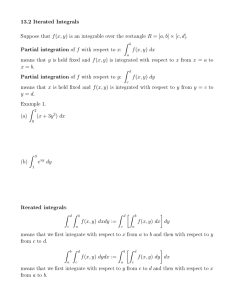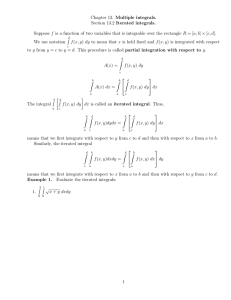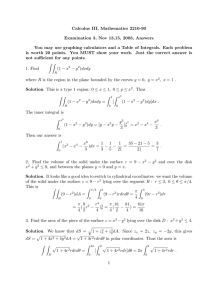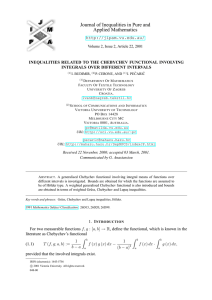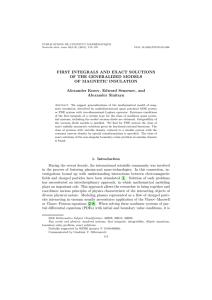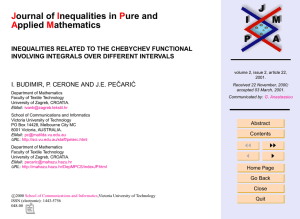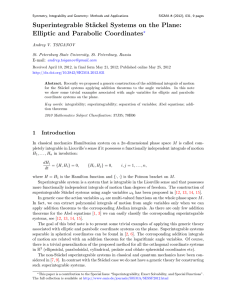Chapter 13. Multiple integrals. Section 13.3 Double integrals over general regions.
advertisement
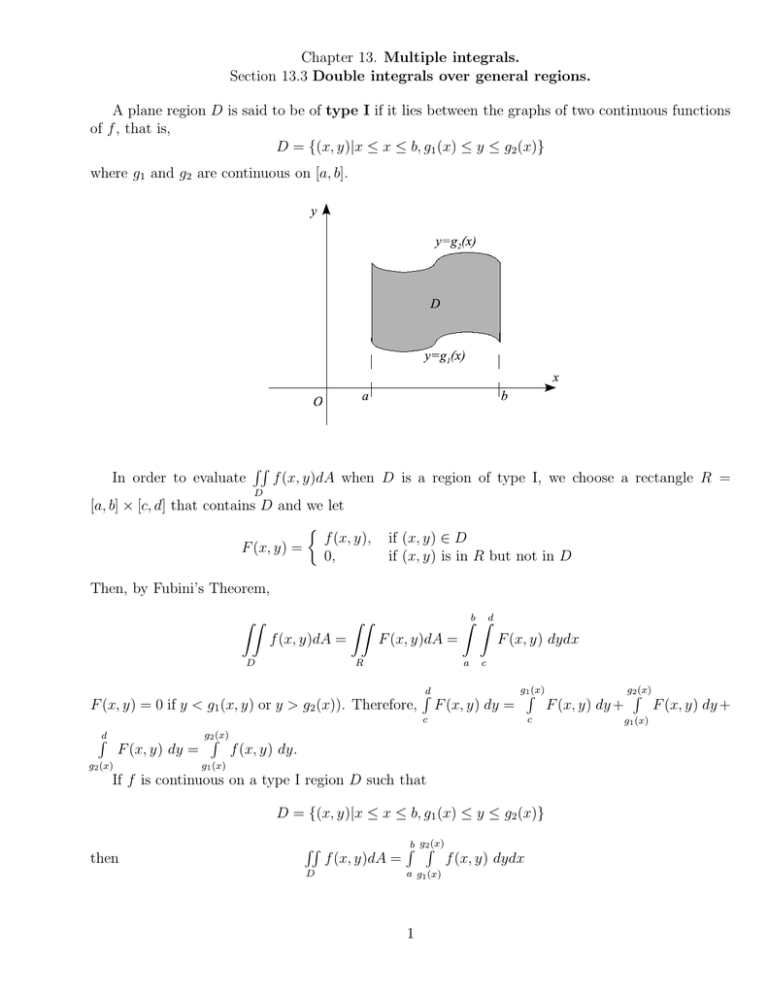
Chapter 13. Multiple integrals.
Section 13.3 Double integrals over general regions.
A plane region D is said to be of type I if it lies between the graphs of two continuous functions
of f , that is,
D = {(x, y)|x ≤ x ≤ b, g1 (x) ≤ y ≤ g2 (x)}
where g1 and g2 are continuous on [a, b].
In order to evaluate
RR
f (x, y)dA when D is a region of type I, we choose a rectangle R =
D
[a, b] × [c, d] that contains D and we let
f (x, y),
F (x, y) =
0,
if (x, y) ∈ D
if (x, y) is in R but not in D
Then, by Fubini’s Theorem,
ZZ
f (x, y)dA =
D
ZZ
F (x, y)dA =
a
R
F (x, y) = 0 if y < g1 (x, y) or y > g2 (x)). Therefore,
Rd
F (x, y) dy =
g2 (x)
g2R(x)
F (x, y) dydx
c
F (x, y) dy =
c
Rd
Zb Zd
g1R(x)
c
f (x, y) dy.
g1 (x)
If f is continuous on a type I region D such that
D = {(x, y)|x ≤ x ≤ b, g1 (x) ≤ y ≤ g2 (x)}
then
RR
D
f (x, y)dA =
Rb g2R(x)
a g1 (x)
1
f (x, y) dydx
F (x, y) dy +
g2R(x)
g1 (x)
F (x, y) dy +
Example 1. Evaluate the integral
if D = {(x, y)|0 ≤ x ≤ 1, x2 ≤ y ≤
√
ZZ
xy dA
D
x}.
We also consider the plane region of type II, which can be expressed as
D = {(x, y)|c ≤ y ≤ d, h1 (y) ≤ x ≤ h2 (y)}
where h1 and h2 are continuous.
We can show that
ZZ
Zd hZ2 (y)
f (x, y)dA =
f (x, y) dxdy
D
c h1 (y)
where D is a type II region.
Example 2. Evaluate the double integrals
ZZ
(y 2 − x) dA,
D
2
where D is bounded by x = y 2 and x = 3 − 2y 2.
Properties of double integrals.
We assume that all of the following integrals exist. Then
RR
RR
RR
1.
[f (x, y) + g(x, y)]dA =
f (x, y)dA +
g(x, y)dA
D
2.
RR
D
cf (x, y)dA = c
D
RR
D
f (x, y)dA, where c is a constant
D
3. If f (x, y) ≥ g(x, y) for all (x, y) in D, then
ZZ
ZZ
f (x, y)dA ≥
g(x, y)dA
D
R
4. If D = D1 ∪ D2 , where D1 and D2 do not overlap except perhaps on their boundaries, then
ZZ
ZZ
ZZ
f (x, y)dA =
f (x, y)dA +
f (x, y)dA
D
5.
RR
D1
D2
1 dA = A(D)
D
6. If m ≤ f (x, y) ≤ M for all (x, y) in D, then
ZZ
f (x, y)dA ≤ MA(D).
mA(D) ≤
D
3
Example 3. Evaluate
ZZ
yex dA
D
if D is the triangular region with vertices (0, 0), (2, 4), and (6, 0).
Example 4. Sketch the region of integration and change the order of integration for
Z1 Z2−y
f (x, y) dxdy
0
y2
4
Example 5. Find the volume of the solid under the paraboloid z = 3x2 + y 2 and above the
region bounded by y = x and x = y 2 − y.
5
